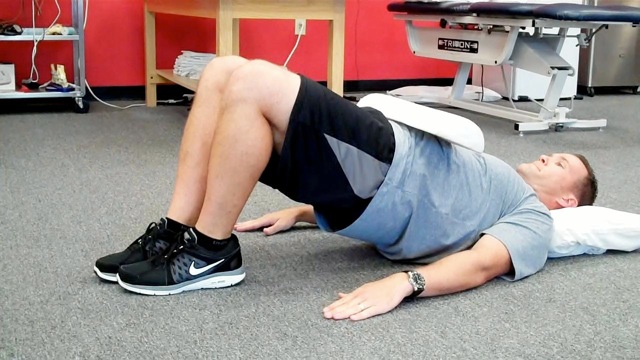
Many of the clients and patients I see struggle with glute activation and pelvic stability. Imbalances and injuries often lead to poor postural control and the inability to maintain a level pelvis in single leg support.
Contralateral muscular control is often an issue that either contributes to injury or results from one. To work on eliminating weakness, increasing muscle endurance and facilitating optimal core and hip stability, I like to use isometric bridging with alternate leg knee extensions.
Execution:
Contralateral muscular control is often an issue that either contributes to injury or results from one. To work on eliminating weakness, increasing muscle endurance and facilitating optimal core and hip stability, I like to use isometric bridging with alternate leg knee extensions.
Execution:
|
|
|
|
Regression:
To advance to this particular exercise, I require that clients master the following sequence of exercises:
1. Double leg isometric bridge (half roll) and good stability for no less than 30 seconds
2. Double leg isometric bridge (half roll) with alternate leg heel raises
3. Double leg isometric bridge (half roll) with small marching steps
Progression:
To advance the exercise, simply lengthen the pause at full knee extension to 3-5 seconds for each repetition. Beyond this, I move to a full active single leg bridge on one leg.
Application:
This exercise is an effective tool for improving hip and core strength and stability in all clients. It is particularly effective in knee injury prevention programs, addressing common imbalances in females with anterior knee pain, working with runners and helping all competitive athletes and weekend warriors attain better pillar strength. This can be used as a pillar prep (corrective) exercise and a precursor to more advanced isotonic single leg hip bridge work.
Brian Schiff, PT, OCS, CSCS, is a licensed physical therapist, respected author and fitness professional. Currently, he serves as the supervisor at the Athletic Performance Center in Raleigh, NC. Brian presents nationally at several professional conferences and seminars on injury prevention, rehab and sport-specific training. For more cutting edge training information, subscribe to his monthly Training & Sports Medicine Update at www.BrianSchiff.com.
1. Double leg isometric bridge (half roll) and good stability for no less than 30 seconds
2. Double leg isometric bridge (half roll) with alternate leg heel raises
3. Double leg isometric bridge (half roll) with small marching steps
Progression:
To advance the exercise, simply lengthen the pause at full knee extension to 3-5 seconds for each repetition. Beyond this, I move to a full active single leg bridge on one leg.
Application:
This exercise is an effective tool for improving hip and core strength and stability in all clients. It is particularly effective in knee injury prevention programs, addressing common imbalances in females with anterior knee pain, working with runners and helping all competitive athletes and weekend warriors attain better pillar strength. This can be used as a pillar prep (corrective) exercise and a precursor to more advanced isotonic single leg hip bridge work.
Brian Schiff, PT, OCS, CSCS, is a licensed physical therapist, respected author and fitness professional. Currently, he serves as the supervisor at the Athletic Performance Center in Raleigh, NC. Brian presents nationally at several professional conferences and seminars on injury prevention, rehab and sport-specific training. For more cutting edge training information, subscribe to his monthly Training & Sports Medicine Update at www.BrianSchiff.com.
 Begin supine with the knees bent 90 degrees. Find a neutral spine position and place a half foam roll on the lower abdomen. Next, perform a full double leg bridge and hold in a table top position. The goal is to keep the roll still and pelvis level at all times.
Begin supine with the knees bent 90 degrees. Find a neutral spine position and place a half foam roll on the lower abdomen. Next, perform a full double leg bridge and hold in a table top position. The goal is to keep the roll still and pelvis level at all times. Now slowly extend one knee, pause at full extension and then return to double leg support. Repeat on the other side. Perform 5-10 repetitions on each leg or repeat for time. It is necessary to coach clients to maintain a tight core and avoid collapsing into an anterior pelvic tilt during the isometric hold. Discontinue the exercise (rest or regress it) if form is lost and cannot be corrected with simple verbal or tactile cueing.
Now slowly extend one knee, pause at full extension and then return to double leg support. Repeat on the other side. Perform 5-10 repetitions on each leg or repeat for time. It is necessary to coach clients to maintain a tight core and avoid collapsing into an anterior pelvic tilt during the isometric hold. Discontinue the exercise (rest or regress it) if form is lost and cannot be corrected with simple verbal or tactile cueing.















